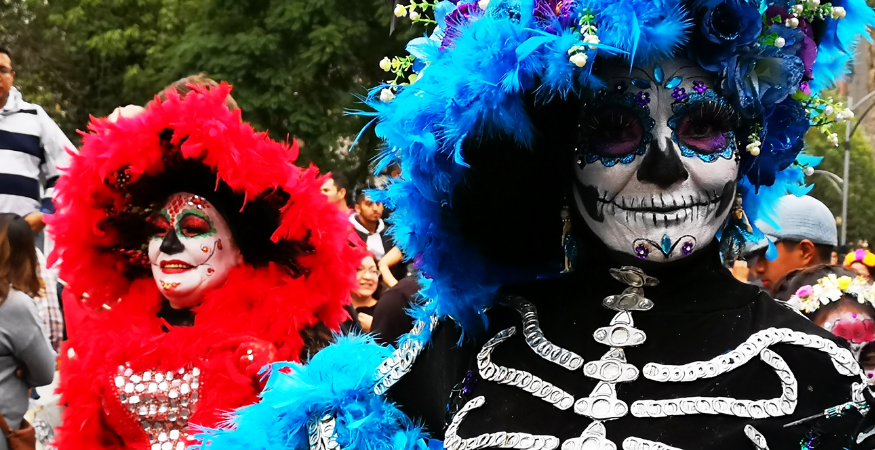| Read time: 5 mins
We often talk about ‘thinking outside of the box’ when it comes to event planning and how cemeteries can raise their profile and attract new visitors. In practice, that may require a small leap - a re-thinking - if you will, of cemeteries, not just as places for the dead, but as places to bring the living together. A place, not only of reflection and remembrance, but as a vital community hub, in which to share and celebrate a rich history and culture.
Read how cemeteries are thinking outside the box.
What’s in a date?
Calendar dates provide an opportunity to create events that will educate, engage and yes, even entertain - building interest in who you are, what you do and what you have to offer.
Creating a calendar of events is a great way to generate ideas, focus your energies and get people engaged. Specific dates that are traditionally marked, observed and celebrated can create focal points around which events can be created - and every good cemetery event calendar should take account of them.
The why
First, let’s start with the why.
It’s never a bad idea to think about the ‘why’ when thinking about event planning. After all, the why will help to shape direction, provide ideas for suitable activities, and ultimately, help you to assess how successful you’ve been.
For some, that may be for fundraising, as revenue generators; they may be purely to promote the cemetery's historical or cultural significance; to encourage volunteers to become involved with the cemetery, to educate on the services provided); to celebrate and commemorate significant dates; or simply to build stronger ties with the community.
In each case, you can start to see the type of event that might marry best with the ultimate goal or desired outcome. Fundraising? That might be a charity walk, promoting historical significance? Guided tours, or living history events. Education and outreach? Information days on burial options or genealogy searches.
With all of that in mind, let’s look at some specific calendar dates, along with some practical examples of how they can be used to engage and generate interest in your cemetery.
Days of remembrance
Observed on the last Monday of May, Memorial Day is a national holiday honoring those who died serving in the US armed forces. It’s a busy day for many cemeteries, with many hosting a range of events and activities for visitors paying their respects.
These might include flag placements, often involving volunteers or other community groups coming together to place flags on the graves of military personnel. As with Remembrance Sunday in the UK, wreath-laying ceremonies are common, with speeches and appropriately respectful displays of pageantry. Some cemeteries may offer guided tours, showing the cemetery in the broader historical context for those who have served.
Watch Memorial Day at Inglewood Park Cemetery.
Mother’s and Father’s Days
Mother’s and Father’s Days present an opportunity to invite families into the cemetery to remember and celebrate loved ones who have passed. They’re a great way to widen the scope of what you can provide, as well as widening your audience to include young people and children.
Family-friendly events and interactive activities that create a positive atmosphere might include picnics, scavenger hunts or even crafting, with some cemeteries utilizing social media channels, inviting families to share stories or reminiscences of their loved ones.
Cemeteries thinking in terms of revenue generators, or providing ‘added value’ for visitors, may consider bespoke memorial gifts, flowers or catering services.

Culturally significant days
There are many days that hold cultural significance for communities, and provide an opportunity to share in and celebrate traditions and cultural diversity. They’re also a great way to encourage people to view you in an entirely different way, as well as attracting visitors from beyond your immediate catchment area.
Dia de Los Muertos, or Day of the Dead, for example is an important holiday originating in Mexico and is also celebrated in parts of the US. Held at the beginning of November, it’s an opportunity for families to celebrate and honor family members who have passed, with events held in cemeteries being vibrant, colorful affairs, full of life, food, family, music, dancing and fun.
A real family affair, alongside food trucks and traditional dance, sugar skulls can feature in arts and crafts for children; while families create altars to the dead on the graves of their relatives.
Inglewood Park Cemetery in Los Angeles, for example, has seen great success with their Day of the Dead events, attracting thousands who wouldn’t normally come to the cemetery to share in the experience.
Maximizing the opportunity, the team had booths onsite providing information on burial options, as well as costs and preplanning - not only helping to generate leads, but providing a valued service to visitors.
Read how 3 cemeteries are reinventing community engagement with Dia de Los Muertos.
Religious holidays
Religious holidays, as a time of reflection and gathering also provide an opportunity to bring people together and provide meaningful ways for cemeteries to connect with their communities. All Souls and All Saints Days, of particular significance to the Christian faith, are marked at the beginning of November.
The Diocese of Oakland, California, for example, with its culturally diverse community, runs night time candlelit vigils on Souls Day where members of the community gather at the cemetery after dark, lit up with paper lanterns that have been placed all throughout the grounds.
Read more on All Saints and All Souls days for cemeteries.
Easter, of course, another Chrisian holiday, provides an opportunity for fun, family-centric events that can create a festive atmosphere - eggs hidden around cemetery grounds can become easter egg hunts, with readings, performances or other non or inter-denominational activities that encourage and welcome people from all backgrounds and faiths.
Seasonal holidays
Speaking of festive atmospheres, both Christmas and Halloween present a wealth of opportunities for cemeteries to harness the ‘spirit’ of the holiday seasons.
For Halloween, both the associated iconography and sense of place and history make them ideal venues for events that can delight and engage new visitors.
Cemetery tours during the hours of darkness can provide fun for young and old, while exploring the history of the site - especially if there are macabre tales to tell; costume contests or pumpkin carving can inspire creativity, while outdoor movie nights deliver something wholly unique for an evening that will live long in the memory. Halloween is certainly a time that rewards a fertile imagination.
Christmas on the other hand, evokes an altogether different spirit in hearts and minds. Candlelit services, musical performances, or even craft fairs hosted within the cemetery can help to bring people together with a sense of togetherness at a time of relfection for many.
Historical dates
Significant dates for both the cemetery and the town also provide an opportunity for engaging and inspiring educational events.
Walking tours or living history activities can provide immersive experiences that can bring your history to life, as visitors interact with historical figures, while learning about your social, historical and even political history, in order to gain a deeper understanding of your shared past.
Forest Home in Milwaukee for example, has seen great success in providing tours on local themes covering the city’s history, with costumed actors, drawing in thousands of people, and has allowed them to generate additional sources of income.
Read how Forest Home shares its beauty, history and nature with the living.

Partnerships
You needn’t be limited solely to specific dates for inspiration. Partnerships are perhaps one of your greatest enablers when it comes to realizing a full, vital and successful events calendar.
From local cultural, historical and genealogy societies to schools, universities, conservation or environmental groups, cultural groups, bird-watching societies, parents groups, youth groups, scouts, guides - there is a huge list of organizations with whom you can collaborate to realize valuable opportunities to cultivate a real sense of community.
Educational programs, history days, talks, tours, sponsored events, concerts to name just a few….soon your calendar will be filling up.
In short, build partnerships, pull resources and get them involved in your event planning.
Your audience
Just finally, while we’re thinking about the why and the what, it’s also a good idea to keep in mind the ‘who’.
Knowing who you want to attract will again help to shape your events. Who are they, where do they live, what’s their background, what are their interests? Are you catering for their needs?
Are you thinking about children and young people…not forgetting…millennials are now becoming decision makers in their own right, holding influence and helping family members make important decisions.
What might an event for young people look like, for example, and how might that differ from one for older people? What are they interested in and what will hold their attention?
Consider your audience and tailor your event to help ensure they are engaged and inspired.
Whatever you do, when you do it and how you do it - whether it's a midnight ghost tour at halloween, a bird-watching trip in the spring, or a family picnic in the summer, make sure your calendar date is the right for you and right for your audience.

